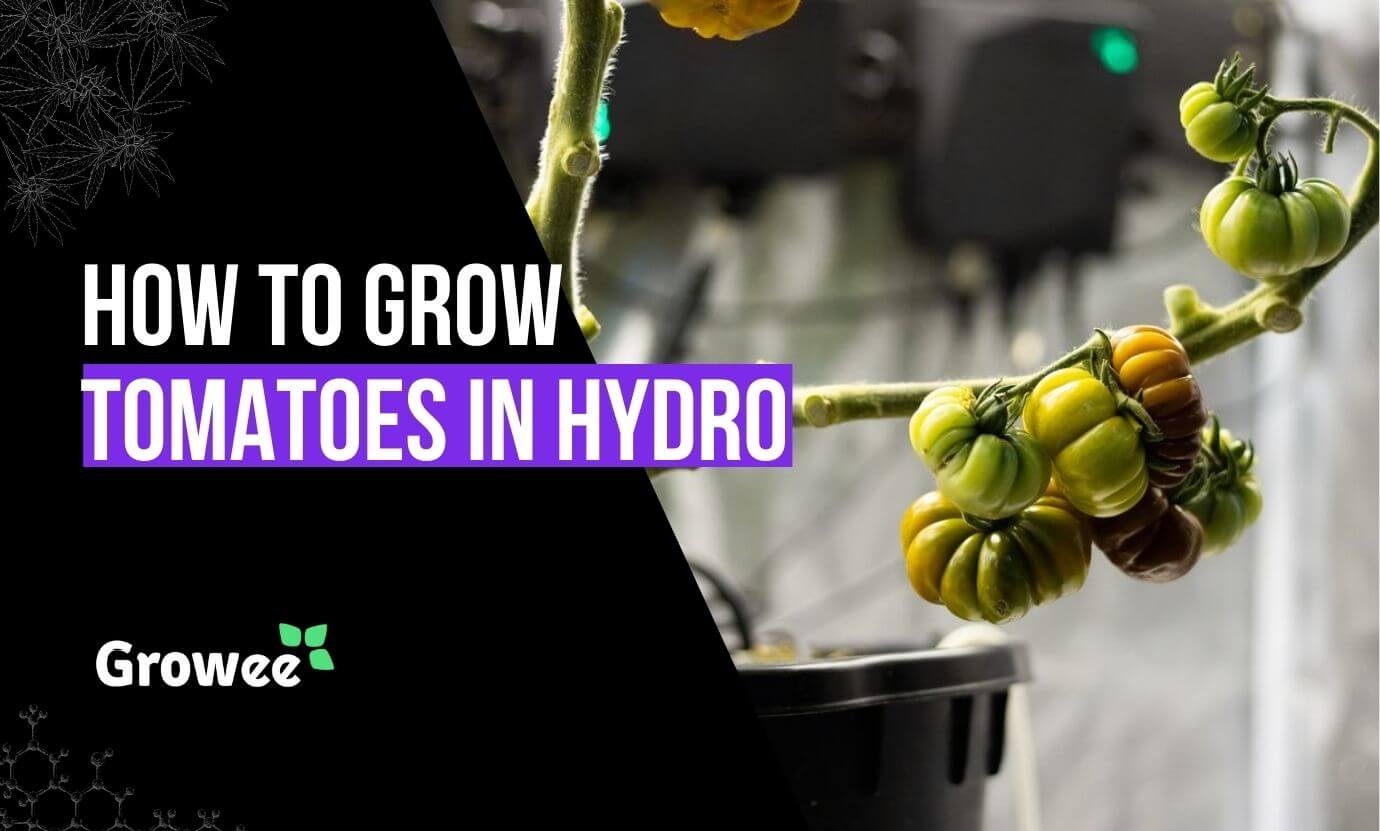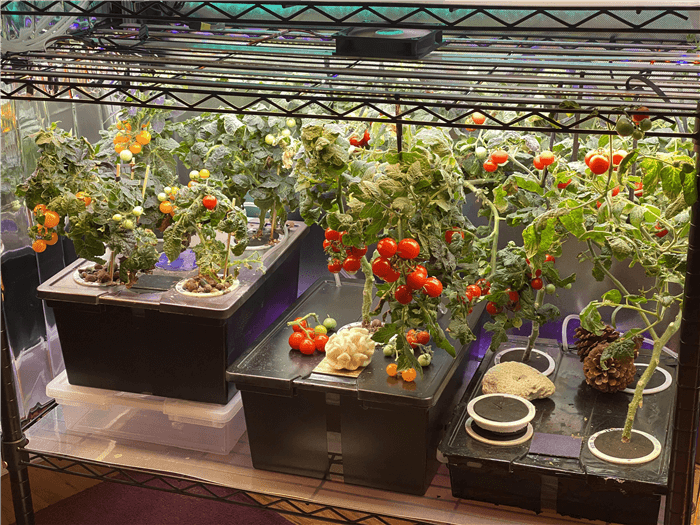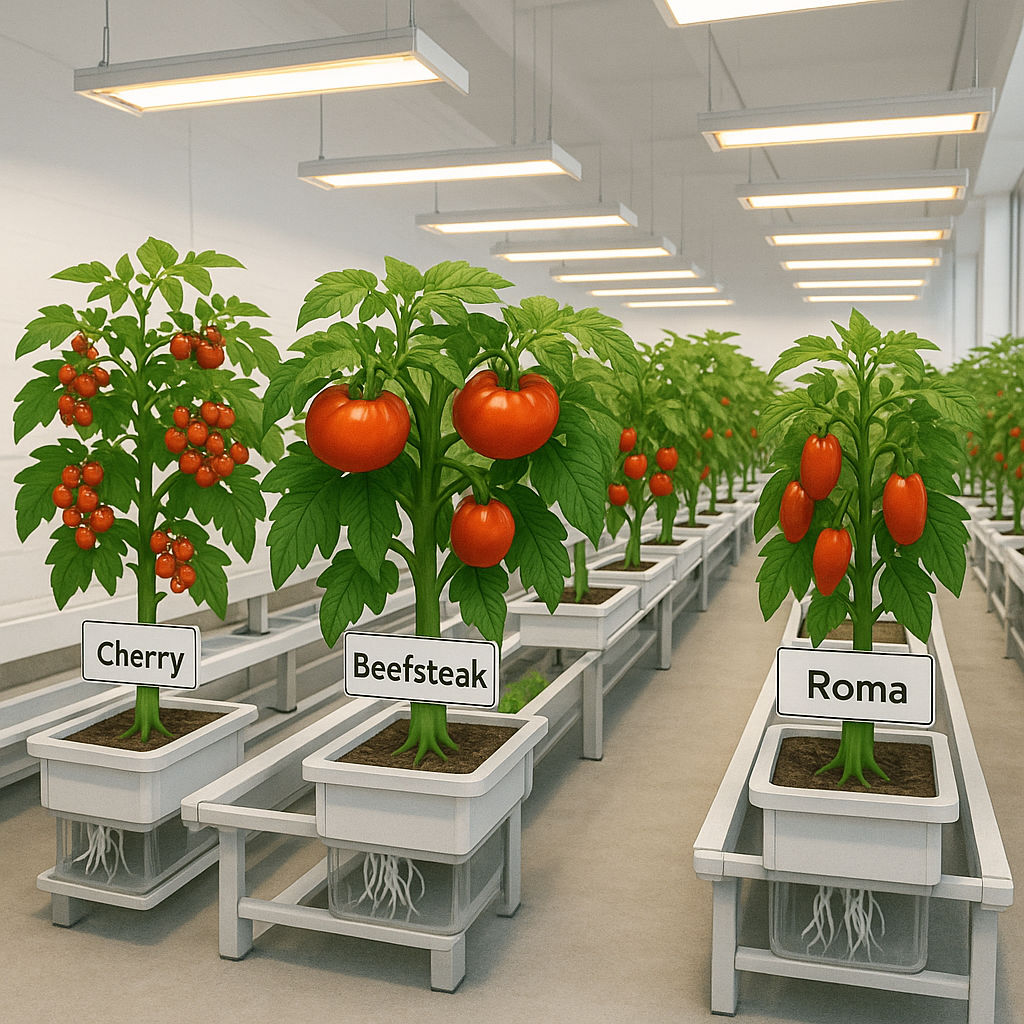Mastering Hydroponic Tomatoes: Your Ultimate Guide to Year-Round Freshness
Estimated reading time: 12 minutes
Key Takeaways
- Growing **hydroponic tomatoes** offers a way to enjoy fresh, flavorful tomatoes year-round, regardless of climate or space.
- Hydroponics is a soil-less method that uses nutrient-rich water solutions for optimal plant growth, leading to faster growth, higher yields, and water conservation.
- Selecting the right tomato varieties, considering factors like plant size and growth habit, is crucial for hydroponic success.
- Understanding different hydroponic systems (DWC, NFT, Drip) and their pros and cons will help you choose the best fit for your needs.
- Maintaining the correct balance of essential nutrients, along with appropriate pH and EC levels, is vital for healthy hydroponic tomatoes.
- A step-by-step approach covering germination, transplanting, environmental control, and harvesting is key to successful cultivation.
- Troubleshooting common issues like wilting, yellowing leaves, and poor fruit set requires careful monitoring of the system and environmental factors.
Table of contents
- Mastering Hydroponic Tomatoes: Your Ultimate Guide to Year-Round Freshness
- Key Takeaways
- Introduction to Hydroponic Tomatoes
- What are Hydroponic Tomatoes and Why Grow Them?
- Choosing the Best Hydroponic Tomato Varieties
- Understanding Hydroponic Tomato Systems Explained
- A Hydroponic Tomato Nutrients Guide
- Step-by-Step Guide to Growing Hydroponic Tomatoes
- Troubleshooting Common Issues in Hydroponic Tomato Growing
- Concluding Thoughts on Hydroponic Tomatoes
Introduction to Hydroponic Tomatoes
Imagine the sheer delight of picking perfectly ripe, intensely flavorful tomatoes straight from your own home, any time of the year. This isn’t a distant dream; it’s the exciting reality that **hydroponic tomatoes** make possible. Whether your backyard is a concrete jungle or your local climate is less than ideal for tomato cultivation, hydroponics offers an innovative solution. This soil-less growing method harnesses the power of nutrient-rich water solutions to foster robust plant growth, resulting in an abundance of delicious fruit. This comprehensive guide is your roadmap to understanding and mastering **hydroponic tomatoes**, covering everything from the fundamental principles to the sweet reward of harvesting your own bounty.

What are Hydroponic Tomatoes and Why Grow Them?
“Hydroponics” literally translates to “water working.” In practice, it’s a sophisticated and efficient technique for growing plants *without soil*. Instead, plants are nurtured by carefully calibrated mineral nutrient solutions dissolved in water. This method unlocks a world of advantages for tomato cultivation.
The allure of **growing tomatoes hydroponically** extends far beyond simply bypassing the soil. The benefits are substantial and transform the gardening experience:
- Faster Growth Rates: In hydroponic systems, nutrients are delivered directly to the plant’s roots in a readily absorbable form. This means plants don’t expend energy searching for nutrients in soil, allowing them to grow significantly faster.
- Higher Yields: With optimized nutrient delivery, light, and environmental conditions, hydroponic tomato plants often produce substantially more fruit per plant compared to their soil-grown counterparts. You’ll be harvesting more tomatoes, more often.
- Water Conservation: One of the most remarkable advantages is water efficiency. Hydroponic systems can use up to 90% less water than conventional farming methods. This is because water is recirculated and reused within the system, minimizing waste.
- Reduced Pests and Diseases: By eliminating soil, you also eliminate a primary source of many soil-borne pests and diseases. This significantly reduces the risk of common tomato ailments, leading to healthier, more vigorous plants.
- Efficient Space Utilization: Hydroponic setups are incredibly versatile and can be configured vertically or in compact arrangements. This makes them perfect for urban gardening, small apartments, or any space where traditional gardening is not feasible.

These advantages make **growing tomatoes hydroponically** a compelling option for both novice and experienced gardeners seeking a more controlled, efficient, and productive way to grow their favorite fruit. (Sources: Spider Farmer, Gorilla Grow Tent, Upstart Farmers)
Choosing the Best Hydroponic Tomato Varieties
Success in hydroponic tomato growing hinges significantly on selecting the right tomato cultivars. Not all tomato varieties are created equal when it comes to thriving in a soilless environment. Choosing wisely will set you up for greater success and more bountiful harvests. The **best hydroponic tomato varieties** are those that are well-suited to controlled growing conditions and efficient nutrient delivery.
Here are some categories and specific recommendations:
- Indeterminate Types: These are the vining tomatoes that keep on growing and producing fruit throughout the entire growing season. They require more support but reward you with a continuous supply of tomatoes. Excellent choices for hydroponics include:
- Beefsteak: Known for their large size and classic tomato flavor.
- Trust: A robust variety with good disease resistance and excellent yields.
- Geronimo: Another strong performer with good fruit quality, ideal for vertical growth.
- Determinate Types: These varieties are more bush-like. They grow to a predetermined size, set their fruit, and then ripen it all within a relatively short period. This makes them a good choice for those with limited space or who want to process a large harvest at once.
- Bush Early Girl: A popular option for its compact growth habit and early production.
- Cherry Tomatoes: These are often the most forgiving and prolific producers in hydroponic systems. Their small size and continuous fruiting make them a gardener’s favorite.
- Sweet 100: Famous for producing long clusters of exceptionally sweet cherry tomatoes.
- Sungold: A highly favored variety for its incredible sweetness and rich, fruity flavor.

When making your selection for the **best hydroponic tomato varieties**, consider these key factors:
- Plant Size: Will the mature plant comfortably fit within your hydroponic system’s footprint and vertical clearance?
- Growth Habit: Do you prefer the continuous, but more demanding, growth of indeterminate varieties, or the compact, concentrated harvest of determinate types?
- Disease Resistance: Opt for varieties specifically bred for resistance to common tomato diseases. This is a significant advantage in any growing system, including hydroponics.
- Flavor Profile: Ultimately, you want tomatoes that taste great to you! Consider whether you prefer sweet, tangy, or a balanced flavor.
By carefully selecting your tomato varieties, you significantly increase your chances of a successful and delicious hydroponic harvest. (Sources: Spider Farmer, Gorilla Grow Tent)
Understanding Hydroponic Tomato Systems Explained
The heart of any hydroponic operation is the system itself. These **hydroponic tomato systems explained** provide the framework for delivering water and essential nutrients directly to the plant roots. The choice of system often depends on your available space, budget, and the level of complexity you’re comfortable with.
Let’s explore some of the most common and effective hydroponic systems for growing tomatoes:
- Deep Water Culture (DWC): In this straightforward system, the roots of your tomato plants are suspended directly in a reservoir filled with nutrient-rich, oxygenated water. Air stones are used to ensure adequate oxygen supply to the roots, which is critical for healthy growth. DWC is relatively simple to set up and is effective for many types of plants, including smaller tomato varieties. (Source: Spider Farmer)
- Nutrient Film Technique (NFT): NFT systems are known for their efficiency. Plants are typically placed in channels, and a continuous, shallow stream of nutrient solution flows over their bare roots. This constant flow ensures excellent oxygenation and nutrient uptake. NFT is particularly well-suited for smaller, faster-growing plants, but can be adapted for tomatoes with careful management.
- Drip Systems: These are among the most versatile and widely used hydroponic systems, especially for larger plants like tomatoes. Nutrient solution is pumped from a reservoir and delivered to the base of each plant through a network of tubes and emitters. The excess solution can be recirculated or drained away, depending on the system design. Drip systems allow for precise control over watering and feeding. (Source: Gorilla Grow Tent)
- Aeroponics: This is a more advanced method where plant roots hang suspended in the air within a chamber. The roots are periodically misted with a nutrient solution. Aeroponics provides exceptional oxygenation to the roots, which can lead to very rapid growth. However, it requires precise control of misting cycles and is more susceptible to power outages.

When comparing these **hydroponic tomato systems**, consider:
- Setup Cost: DWC and simple drip systems tend to be more affordable initially than complex NFT or aeroponic setups.
- Maintenance Requirements: All systems require regular monitoring of nutrient levels and pH. However, systems with fewer moving parts might require less day-to-day attention.
- Scale of Growing: For a few plants, a simple DWC or a small drip system might be ideal. For larger operations, NFT or more sophisticated drip systems might be more efficient.
Understanding these **hydroponic tomato systems explained** will empower you to choose the setup that best aligns with your goals and resources. (Sources: Spider Farmer, Gorilla Grow Tent)
A Hydroponic Tomato Nutrients Guide
In a soil-less environment, the nutrient solution is the lifeblood of your **hydroponic tomatoes**. Providing the correct balance of nutrients is not just important; it’s paramount for healthy growth, disease resistance, and abundant fruit production. This **hydroponic tomato nutrients guide** will help you navigate the essentials.
Tomatoes, like all plants, require a specific set of nutrients to thrive. These can be broadly categorized:
- Macronutrients: These are needed in larger quantities.
- *Nitrogen (N):* Essential for vegetative growth, leaf development, and chlorophyll production.
- *Phosphorus (P):* Crucial for root development, flowering, and fruiting.
- *Potassium (K):* Supports overall plant health, water regulation, and fruit quality.
- *Calcium (Ca):* Vital for cell wall structure and integrity, preventing issues like blossom end rot.
- *Magnesium (Mg):* A key component of chlorophyll, essential for photosynthesis.
- *Sulfur (S):* Important for protein synthesis and enzyme activity.
(Sources: Instructables, Gorilla Grow Tent)
- Micronutrients: These are required in smaller amounts but are equally vital. They include Iron (Fe), Zinc (Zn), Copper (Cu), Manganese (Mn), Boron (B), and Molybdenum (Mo). These play critical roles in various enzymatic and metabolic processes within the plant.

Managing your nutrient solution is key:
- Mixing: Always use pre-formulated hydroponic nutrient solutions designed for fruiting plants. Follow the manufacturer’s instructions meticulously for mixing ratios. Never mix concentrated nutrients directly together; always dilute them in water.
- pH Levels: This is one of the most critical parameters. The pH of your nutrient solution determines the availability of nutrients to the plant’s roots. For tomatoes, the ideal pH range is typically between **5.5 and 6.5**. Use a pH meter to monitor this regularly and pH adjusters (pH Up and pH Down) to maintain the target range. (Sources: Gorilla Grow Tent, Mars Hydro)
- Electrical Conductivity (EC) / Total Dissolved Solids (TDS): EC or TDS measurements indicate the concentration of dissolved salts (nutrients) in your water. A consistent EC reading ensures your plants are receiving the right amount of food – not too little (underfeeding) and not too much (nutrient burn or lockout). Use an EC or TDS meter and refer to nutrient manufacturer guidelines for the appropriate range for tomatoes at different growth stages. (Sources: Gorilla Grow Tent, Mars Hydro)
Diagnosing Deficiencies: Observe your plants closely. Yellowing leaves can indicate nitrogen or iron deficiency. Stunted growth might point to a lack of phosphorus or potassium. Poor fruit set can be related to calcium issues or insufficient micronutrients. By understanding the symptoms, you can adjust your nutrient solution to correct these problems. Regularly changing your nutrient reservoir (typically every 1-2 weeks) is also a good practice to prevent nutrient imbalances and buildup of unwanted salts.
A well-managed nutrient solution is fundamental to the success of your **hydroponic tomatoes**. (Sources: Gorilla Grow Tent, Mars Hydro)
Step-by-Step Guide to Growing Hydroponic Tomatoes
Embarking on the journey of **growing tomatoes hydroponically** is an exciting endeavor. By following a structured approach, you can navigate the process from seed to a bountiful harvest with confidence.
Here’s a step-by-step guide to help you cultivate your **hydroponic tomatoes**:
- Seed Germination: Begin by germinating your chosen tomato seeds. This is typically done in small, inert starter plugs like rockwool cubes, coco coir plugs, or peat pellets. Keep them consistently moist and warm until germination occurs. (Sources: Gorilla Grow Tent, Mars Hydro, Instructables)
- Transplanting Seedlings: Once your seedlings have developed their first set of true leaves and a healthy root system, they are ready to be transplanted into your chosen hydroponic system. Carefully place the starter plug containing the seedling into the net pot or growing medium within your system, ensuring the roots can reach the nutrient solution. (Sources: Gorilla Grow Tent, Mars Hydro)
- Environmental Control: Tomatoes are sun-loving plants and require specific environmental conditions to flourish:
- Light: Provide at least 16 hours of high-quality light per day. If natural light is insufficient, use full-spectrum LED grow lights. The intensity and duration of light are critical for flowering and fruit development.
- Temperature: Aim for daytime temperatures between 20-25°C (68-77°F). Slightly cooler nighttime temperatures (around 15-18°C or 60-65°F) can be beneficial for fruit set. Avoid extreme temperature fluctuations.
- Humidity & Airflow: Good air circulation is essential to prevent fungal diseases and mold. Use fans to ensure steady airflow around the plants. Maintain moderate humidity levels, generally between 40-60%. (Source: Mars Hydro)
- Plant Support and Pruning: As tomato plants grow, especially indeterminate varieties, they will require support. Use stakes, trellises, cages, or other support structures to keep the plants upright and prevent branches from breaking under the weight of the fruit. Pruning “suckers” – the small shoots that grow in the V-shape between the main stem and a branch – is also beneficial. Removing suckers helps direct the plant’s energy into producing larger, higher-quality fruit rather than excessive foliage.
- Pest and Disease Management: While hydroponics significantly reduces soil-borne issues, it doesn’t eliminate all problems. Regularly inspect your plants for signs of pests like aphids, whiteflies, or spider mites, and for fungal diseases such as powdery mildew or botrytis. Employ preventative measures like good airflow and sanitation. If issues arise, opt for organic pest control methods suitable for hydroponic systems. (Source: Gorilla Grow Tent)
- Harvesting: The moment of truth! Your **hydroponic tomatoes** are ready to be harvested when they have reached their full, mature color (depending on the variety – red, yellow, orange, etc.) and have a firm yet slightly yielding texture. Gently twist or snip the tomatoes from the vine, leaving a small piece of stem attached if desired. Enjoy the unparalleled freshness and flavor! (Source: Gorilla Grow Tent)

This detailed approach to **growing tomatoes hydroponically** will guide you toward a successful and rewarding cultivation experience.
Troubleshooting Common Issues in Hydroponic Tomato Growing
Even with the best intentions, you might encounter challenges when **growing tomatoes hydroponically**. Understanding and addressing these common issues promptly can save your plants and ensure a successful harvest.
Here are some frequent problems and their solutions:
- Wilting Plants: This can be alarming, but it often stems from a lack of water or oxygen to the roots.
- Check the water level in your reservoir. Is it sufficient?
- Ensure your pump is functioning correctly and circulating water.
- Verify that your air stones are producing bubbles to oxygenate the water. If not, clean or replace them.
- Inspect the roots for any signs of rot or blockage in the system.
- Yellowing Leaves: This symptom can point to several underlying issues, most commonly nutrient deficiencies or pH imbalances.
- Nitrogen Deficiency: Often causes yellowing of older, lower leaves first.
- Iron Deficiency: Typically results in yellowing of new growth, with veins remaining green (interveinal chlorosis).
- pH Imbalance: If the pH is too high or too low, plants cannot absorb essential nutrients, even if they are present in the solution. Refer back to the **hydroponic tomato nutrients guide** for correct pH levels and how to adjust them.
- Check your EC/TDS levels; an incorrect concentration can also lead to nutrient issues.
- Poor Fruit Set: If your plants are flowering but not producing fruit, consider these factors:
- Insufficient Light: Tomatoes need adequate light for flowering and pollination. Ensure your lights are on for 16+ hours and are powerful enough.
- Temperature Extremes: Very high or very low temperatures can prevent pollination.
- Lack of Pollination: In indoor environments without wind or insects, pollination might be limited. Gently shake the plant stems daily or use a small, soft brush to transfer pollen from flower to flower, mimicking natural pollination.
- Nutrient Imbalances: A lack of phosphorus or potassium can affect flowering and fruiting.

General problem-solving in hydroponics involves a systematic approach: always start by checking the most fundamental aspects – water level, nutrient concentration (EC/TDS), pH, and the operational status of your pump and air pump. Environmental factors like temperature, humidity, and airflow are also critical. With careful observation and consistent monitoring, most issues encountered when **growing tomatoes hydroponically** can be resolved effectively. (Sources: Gorilla Grow Tent, Mars Hydro)
Concluding Thoughts on Hydroponic Tomatoes
The journey into **hydroponic tomatoes** offers a rewarding pathway to enjoying incredibly fresh, flavorful produce year-round. We’ve explored the significant advantages of this innovative method, including its potential for accelerated growth, higher yields, remarkable water conservation, and a reduction in common pests and diseases. The ability to cultivate these vibrant fruits irrespective of your local climate or available garden space is a testament to the power of modern horticultural techniques.
By understanding the principles outlined in this guide – from selecting the best varieties and choosing the right system to mastering nutrient management and environmental control – you are well-equipped to embark on your own **growing tomatoes hydroponically** adventure. The insights provided on everything from seed germination to troubleshooting common issues are designed to empower you to achieve successful and delicious harvests.

Embrace this dynamic and efficient approach to gardening. Whether you’re a seasoned gardener looking to optimize production or a complete beginner excited about growing your own food, the world of **hydroponic tomatoes** awaits. Start small, learn as you grow, and savor the unparalleled taste of homegrown, hydroponically-produced tomatoes.












